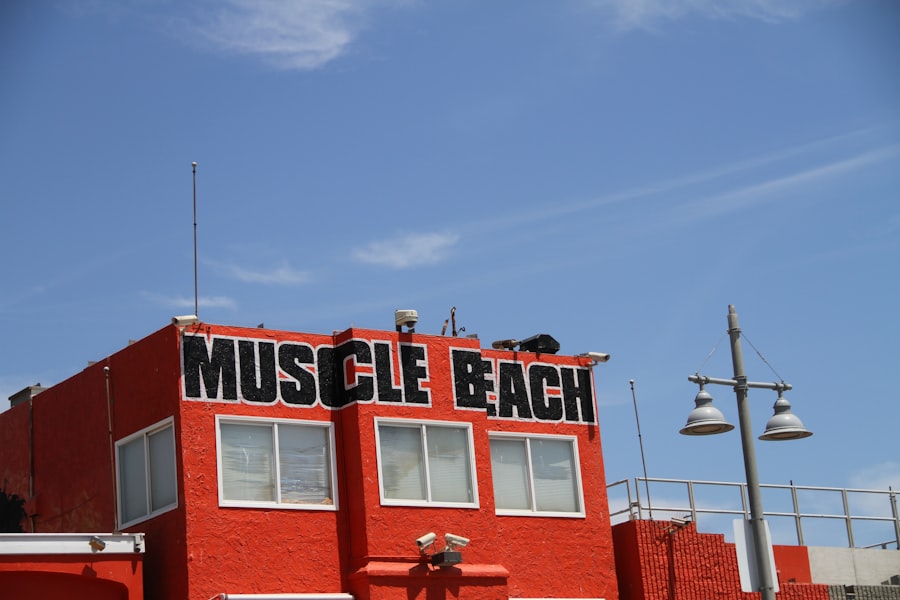As you age, the preservation of muscle mass becomes increasingly vital for maintaining overall health and functionality. Muscle mass is not just about aesthetics; it plays a crucial role in your metabolism, strength, and mobility. When you lose muscle, you may find it more challenging to perform daily activities, which can lead to a decline in your quality of life.
Understanding the importance of preserving muscle mass can motivate you to take proactive steps in your fitness journey. Moreover, maintaining muscle mass is essential for preventing age-related conditions such as osteoporosis and sarcopenia. Sarcopenia, the gradual loss of muscle tissue, can begin as early as your 30s and accelerates with age.
This understanding can empower you to make informed choices about your exercise and nutrition, ultimately leading to a healthier, more active lifestyle.
Key Takeaways
- Preserving muscle mass is important for overall health and functionality, especially as we age.
- Resistance training plays a crucial role in preserving muscle mass and should be incorporated into regular exercise routines.
- Including protein-rich foods in your diet is essential for maintaining and building muscle mass.
- High-intensity interval training can be beneficial for older adults in preserving muscle mass and improving overall fitness.
- Excessive cardiovascular exercise should be avoided as it can lead to muscle loss and hinder muscle preservation efforts.
The Role of Resistance Training in Preserving Muscle Mass
Resistance training is one of the most effective methods for preserving and even building muscle mass as you age. Engaging in regular strength training exercises helps stimulate muscle growth by creating micro-tears in your muscle fibers, which then repair and grow stronger. You might consider incorporating exercises such as weightlifting, bodyweight workouts, or resistance band training into your routine.
These activities not only help maintain muscle mass but also improve bone density and joint health. In addition to physical benefits, resistance training can have a positive impact on your mental well-being. As you lift weights or perform resistance exercises, you may experience a sense of accomplishment and empowerment.
This boost in confidence can translate into other areas of your life, encouraging you to stay active and engaged. By making resistance training a regular part of your fitness regimen, you can effectively combat the natural decline in muscle mass that comes with aging.
Incorporating Protein-Rich Foods into Your Diet

Your diet plays a significant role in preserving muscle mass, and one of the most critical components is protein. Consuming adequate amounts of protein is essential for muscle repair and growth. As you age, your body may require more protein to stimulate muscle protein synthesis effectively.
You should aim to include a variety of protein-rich foods in your meals, such as lean meats, fish, eggs, dairy products, legumes, and nuts. This diverse approach ensures that you receive all the essential amino acids necessary for optimal muscle health. In addition to quantity, the timing of protein intake is also important.
You might consider spreading your protein consumption throughout the day rather than loading up on it during one meal. Research suggests that consuming protein-rich snacks or meals every few hours can enhance muscle protein synthesis and support recovery after workouts. By being mindful of both the quality and timing of your protein intake, you can create a dietary strategy that effectively supports your muscle preservation goals.
The Benefits of High-Intensity Interval Training for Older Adults
| Benefits of High-Intensity Interval Training for Older Adults |
|---|
| 1. Improved cardiovascular health |
| 2. Increased muscle strength and endurance |
| 3. Enhanced metabolism and fat burning |
| 4. Better insulin sensitivity and blood sugar control |
| 5. Improved cognitive function and brain health |
| 6. Reduced risk of chronic diseases such as diabetes and heart disease |
| 7. Enhanced overall physical function and mobility |
High-Intensity Interval Training (HIIT) has gained popularity for its efficiency and effectiveness in improving cardiovascular fitness and preserving muscle mass. For older adults like yourself, HIIT can be particularly beneficial as it allows you to achieve significant results in a shorter amount of time compared to traditional steady-state cardio exercises. By alternating between short bursts of intense activity and periods of rest or lower intensity, you can challenge your muscles while also boosting your metabolism.
Incorporating HIIT into your routine can also enhance your overall functional capacity. As you engage in these high-intensity workouts, you may notice improvements in your endurance, strength, and agility. This increased fitness level can translate into better performance in daily activities, making tasks like climbing stairs or carrying groceries feel easier.
Additionally, HIIT has been shown to have positive effects on mental health by reducing stress and improving mood, making it an excellent choice for maintaining both physical and emotional well-being.
Avoiding Excessive Cardiovascular Exercise
While cardiovascular exercise is essential for heart health and overall fitness, excessive amounts can be counterproductive when it comes to preserving muscle mass. Engaging in long-duration cardio sessions without adequate strength training can lead to muscle loss over time. You should aim for a balanced approach that includes both cardiovascular exercise and resistance training to ensure that you are not sacrificing muscle for endurance.
Instead of spending hours on the treadmill or elliptical machine, consider shorter, more intense cardio sessions that complement your strength training efforts. Activities like cycling, swimming, or brisk walking can provide cardiovascular benefits without compromising your muscle mass. By being mindful of the amount and type of cardio you engage in, you can create a well-rounded fitness routine that supports both heart health and muscle preservation.
The Importance of Adequate Rest and Recovery

Rest and recovery are often overlooked aspects of any fitness regimen but are crucial for preserving muscle mass. When you engage in resistance training or high-intensity workouts, your muscles need time to repair and grow stronger. Without adequate rest, you risk overtraining, which can lead to fatigue, decreased performance, and even injury.
You should prioritize rest days in your workout schedule to allow your body the time it needs to recover fully. In addition to scheduled rest days, consider incorporating active recovery techniques into your routine. Activities such as gentle yoga, stretching, or leisurely walks can promote blood flow and aid in recovery without placing additional stress on your muscles.
By listening to your body and giving it the rest it deserves, you can optimize your training efforts and ensure that you are effectively preserving your muscle mass over time.
Monitoring and Adjusting Your Caloric Intake
As you work towards preserving muscle mass, it’s essential to monitor your caloric intake carefully. Your body requires a certain number of calories to maintain its current weight and support muscle growth. If you’re not consuming enough calories, you may find it challenging to preserve muscle mass while also engaging in regular exercise.
You should aim for a balanced diet that provides sufficient energy while also meeting your nutritional needs. Adjusting your caloric intake based on your activity level is also crucial. If you’re increasing the intensity or frequency of your workouts, you may need to consume more calories to fuel your body adequately.
Conversely, if you’re less active for a period due to injury or other factors, reducing caloric intake may be necessary to prevent unwanted weight gain. By being mindful of your caloric needs and making adjustments as necessary, you can support your muscle preservation goals effectively.
The Role of Supplements in Preserving Muscle Mass
While a well-balanced diet should be your primary source of nutrients, certain supplements can play a supportive role in preserving muscle mass as you age. Protein powders, for instance, can be an excellent way to ensure you’re meeting your daily protein requirements without having to consume large quantities of food. Additionally, branched-chain amino acids (BCAAs) may help reduce muscle soreness and promote recovery after intense workouts.
Other supplements worth considering include creatine and omega-3 fatty acids. Creatine has been shown to enhance strength gains during resistance training while also supporting muscle recovery. Omega-3 fatty acids can help reduce inflammation in the body, which may be beneficial for overall joint health and recovery from exercise-induced stress.
Before adding any supplements to your routine, it’s wise to consult with a healthcare professional or nutritionist to ensure they align with your individual needs.
Addressing Hormonal Changes and Their Impact on Muscle Mass
As you age, hormonal changes can significantly impact your ability to preserve muscle mass. Testosterone levels tend to decline in both men and women as they get older, which can lead to decreased muscle strength and mass. Additionally, changes in growth hormone levels can affect how efficiently your body builds and maintains muscle tissue.
Understanding these hormonal shifts can help you take proactive steps to mitigate their effects. To counteract hormonal changes that may hinder muscle preservation, consider incorporating lifestyle modifications such as regular exercise, a balanced diet rich in nutrients, and stress management techniques like mindfulness or meditation. These strategies can help optimize hormone levels naturally while supporting overall health and well-being.
By being aware of how hormonal changes affect your body, you can take charge of your fitness journey with confidence.
Seeking Professional Guidance and Support
Navigating the complexities of preserving muscle mass as you age can be challenging; seeking professional guidance can make a significant difference in your journey. A certified personal trainer or nutritionist can provide personalized advice tailored to your specific needs and goals. They can help design an effective workout program that incorporates resistance training while also addressing any limitations or concerns you may have.
Additionally, joining a fitness group or community can offer valuable support and motivation as you work towards preserving muscle mass. Surrounding yourself with like-minded individuals who share similar goals can create a sense of accountability while also making the process more enjoyable. Whether through group classes or online forums, connecting with others on a similar journey can provide encouragement and inspiration along the way.
Celebrating Small Victories and Progress in Muscle Preservation
As you embark on the journey of preserving muscle mass, it’s essential to celebrate small victories along the way. Recognizing progress—whether it’s lifting heavier weights, completing an extra set of exercises, or simply feeling more energetic—can boost your motivation and reinforce positive habits. You should take time to acknowledge these achievements rather than solely focusing on long-term goals.
Creating a journal or log to track your workouts and dietary choices can also help you visualize progress over time. Documenting milestones—no matter how small—can serve as a reminder of how far you’ve come on this journey toward preserving muscle mass. By celebrating these victories and maintaining a positive mindset, you’ll be better equipped to stay committed to your fitness goals while enjoying the process along the way.
As we age, maintaining muscle mass becomes increasingly important, especially when trying to lose weight. For individuals over 60, it’s crucial to adopt strategies that protect muscle tissue while shedding excess pounds. A related article on this topic can be found on Explore Senior Health, which provides valuable insights into effective methods for preserving muscle mass during weight loss. The article emphasizes the importance of combining resistance training with adequate protein intake to support muscle health. For more detailed information, you can read the full article by visiting Explore Senior Health.
FAQs
What are the challenges of losing weight over 60 while protecting muscle mass?
As people age, they tend to lose muscle mass, which can make it more challenging to maintain muscle while losing weight. Additionally, the body’s metabolism tends to slow down with age, making it harder to lose weight.
Why is it important to protect muscle mass while losing weight over 60?
Maintaining muscle mass is important for overall health, as it helps support the body’s structure and function. Additionally, preserving muscle mass can help prevent age-related muscle loss and maintain strength and mobility.
What are some strategies for protecting muscle mass while losing weight over 60?
Some strategies for protecting muscle mass while losing weight over 60 include engaging in regular strength training exercises, consuming adequate protein, and getting enough rest and recovery. It’s also important to maintain a balanced and nutritious diet to support muscle health.
How does nutrition play a role in protecting muscle mass while losing weight over 60?
Proper nutrition, including adequate protein intake, is essential for preserving muscle mass while losing weight. Consuming a balanced diet that includes lean protein, healthy fats, and complex carbohydrates can help support muscle health and overall weight loss efforts.
What role does exercise play in protecting muscle mass while losing weight over 60?
Engaging in regular strength training exercises, such as weightlifting or resistance training, can help preserve and build muscle mass while losing weight over 60. Additionally, incorporating cardiovascular exercise and flexibility training can support overall health and fitness.
